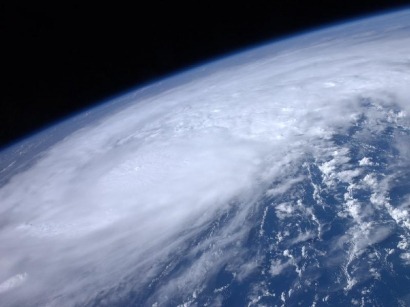
As of early Friday morning, the outer bands of the massive storm were bringing intermittent heavy rains and strong gusts of winds to the South Carolina coast, prompting officials in the Charleston area to close schools and government offices.
Landfall for the worst of the storm is currently expected to occur somewhere between the South Carolina boarder and Cape Hatteras, North Carolina on Saturday. From there is forecast to pass over the state of Virginia and Washington, D.C. and go back out over water, strengthening, before reaching New York City and New England.
Earlier this week, Hurricane Irene ripped through the Bahamas, damaging homes, felling trees and triggering flooding. The photo above, from a YouTube video, shows the hurricane approaching Yonder Cay.
The vantage point is atop a 100-foot wind turbine that later lost one of its blades to the storm.
According to the National Hurricane Centre in Miami, Irene is likely to strengthen over the course of the day on Friday, and could become a Category Four hurricane bearing winds of at least 131 miles per hour by the time it crosses the North Carolina coast.
Much of the storm’s project path takes it over areas off the coast that the U.S. Dept. of Energy has identified as prime for commercial wind energy projects.
Those areas include the coastal waters off the states of Virginia, Delaware, Maryland, New Jersey, Massachusetts, and Rhode Island.
Among those watching the progress of the hurricane are staffers of the Atlantic Wind Connection in Chevy Chase, Maryland.
The Atlantic Wind Connection (AWC) transmission project is expected to provide the essential backbone to harvesting more than 60,000 MW of energy from offshore winds along the Mid-Atlantic US.
Designed to accelerate offshore wind development, the project is led by well-established independent transmission company Trans-Elect and sponsored by Good Energies, Google and Marubeni Corporation.
But if those staffers are interested in Irene on a how-will-it-impact-me-and-my-friends-and-family perspective, an official with the company hastened to add to AWC isn’t formally monitoring the hurricane “as our offshore subsea transmission ‘backbone’ project, the Atlantic Wind Connection, is yet to be constructed”.
“However, before construction starts, it is part of our engineering work to conduct Met-Ocean studies that will determine the ability of our transmission line to withstand increases in pressure, impact of varying wave heights, and other factors,” he said.
The official, who asked not to be quoted by name, as he was not officially representing the views of AWC’s engineering experts, added, “For us, it is essential to study and ensure that natural disasters such as Hurricane Irene will not compromise the reliability of our system”.
Among those most intensely interested in Hurricane Irene’s project strength and path are operators of the oil, natural gas and power infrastructure in the densely-populated US Northeast.
Most if not all have now activated emergency plans ahead of storm and are warning of potential supply disruptions.
While there are currently no immediate plans to shut down New York Harbour, a hub for the delivery of millions of barrels of oil products per day, several coastal oil terminals and pipeline operators said they expect to be at least partially shut down over the weekend to guard against serious damage from the storm.
US Homeland Security Secretary Janet Napolitano on Friday warned East Coast inhabitants to expect extensive power outages. Current estimates suggest that between five million and seven million people could be without power this weekend.
For additional information:

